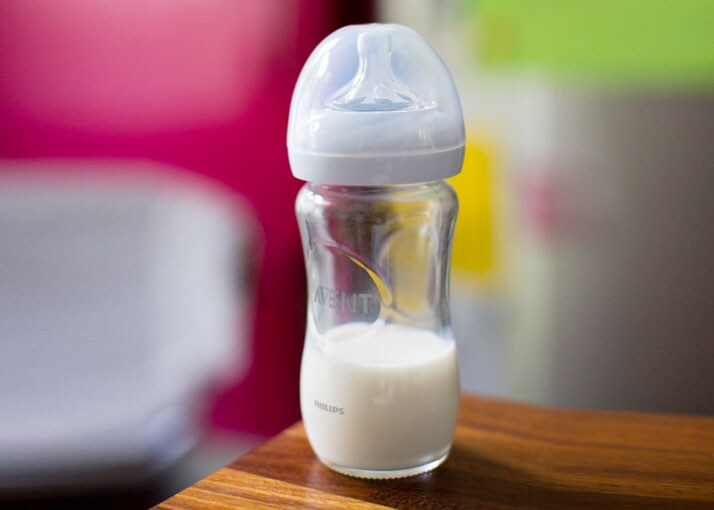Bottle feeding, 0-3 months
What you’ll need
● 6 bottles with nipples and caps
● Milk warmed to body temperature
● A comfortable place to feed
Choosing the right nipple and bottle
Nipples come in many sizes, flows and materials. You’ll find that most bottle nipples are labelled according to a baby’s age, but it’s really only an overall indication. If you notice your little one is spluttering or tensing during feeds, it might be a sign they need a nipple with a slower flow.
Choosing the right bottle for your little one also comes down to their age and their specific needs. Look for a bottle with a venting system to reduce air intake and tummy troubles (most are!) and then choose a size of bottle that suits your baby’s milk intake. If you’re combining breastfeeding with bottle feeding, know that you can also opt for a nipple that mimics the natural shape and feel of the breast.
How much milk
Generally speaking, a healthy baby between 1 -6 months will drink, on average, 25 and 30 oz. (750‐900 ml) per day.
Although it’s tempting to keep a set volume in mind, try not to be too strict on this! Volumes will naturally vary from feed to feed and you’ll know when your little one’s tummy is full by watching for signs such as a look of sleepiness or when their body feels heavy and relaxed.
A comfortable feeding position
Find a comfortable place to sit and hold your baby. The trick here is to find a position you won’t have trouble maintaining for the whole feed. For example. you might like to cradle them in the crook of your arm or sit them upright so their back is against your stomach.
When you’re ready, encourage your baby to open wide by touching the nipple of the bottle to your baby’s lower lip. As your baby opens their mouth, gently introduce the nipple by making sure your baby’s tongue is down.
Tip the bottle so the milk fills the nipple to avoid your little one taking in air as they drink.
The first bottle
If your little one is used to nursing, you’ll probably find that they prefer their first bottles to be given by someone other than mom. Sorry mom, your breast milk can be rather distracting!
Rather than feeding on a schedule, watch for hunger cues such as licking lips, moving arms and legs or bringing hands to mouth as a signal to begin the feed.
If you find your baby tenses at first, gently tilt them and the bottle forward so the milk flow slows. They’ll feel more in control this way. As you continue, let your baby pause and take breaks as they need.
After the feed
Sometimes your little one will take in some air as they drink. You can relieve any discomfort they may be feeling by burping them at the end of the feed or midfeed.
There are two ways you can go about it. The first involves placing your baby on your shoulder and gently rubbing their back. Or, you can try sitting them on your lap slightly tilted forward, supporting their chin and neck with one hand while rubbing their back with your other hand.
What to do with a fussy eater
● Experiment with a slower nipple flow
● Allow caregivers other than mom to feed
● Try a different feeding position
● Offer attention as well as the bottle to make it a positive experience
Bottle feeding and other caregivers
● Give your little one time to get used to other caregivers
● Allow 3 weeks for your baby to get used to bottle feeding if you know they’ll soon be spending more time with another caregiver
● Expect that your baby may crave more attention from you in the evening if you’re away during the day
● Have caregivers keep a log of feeds so you can keep up to date
Want to find a bottle to suit your baby's needs? Click here to explore our range.
